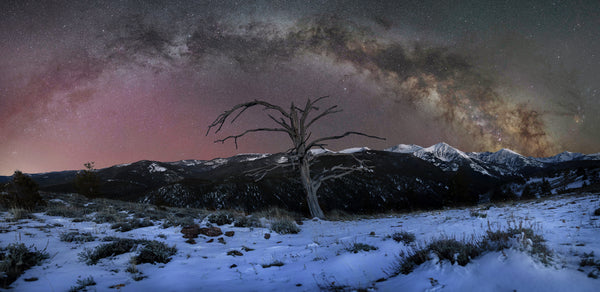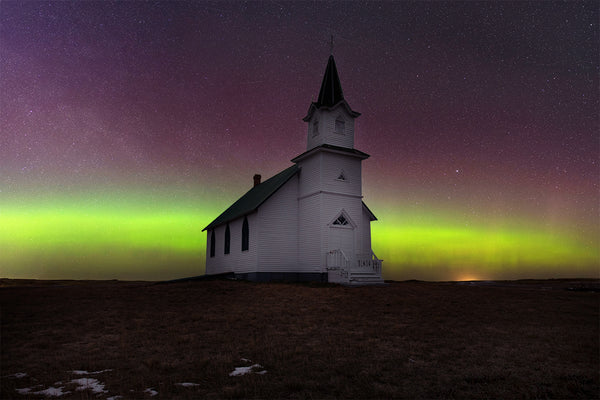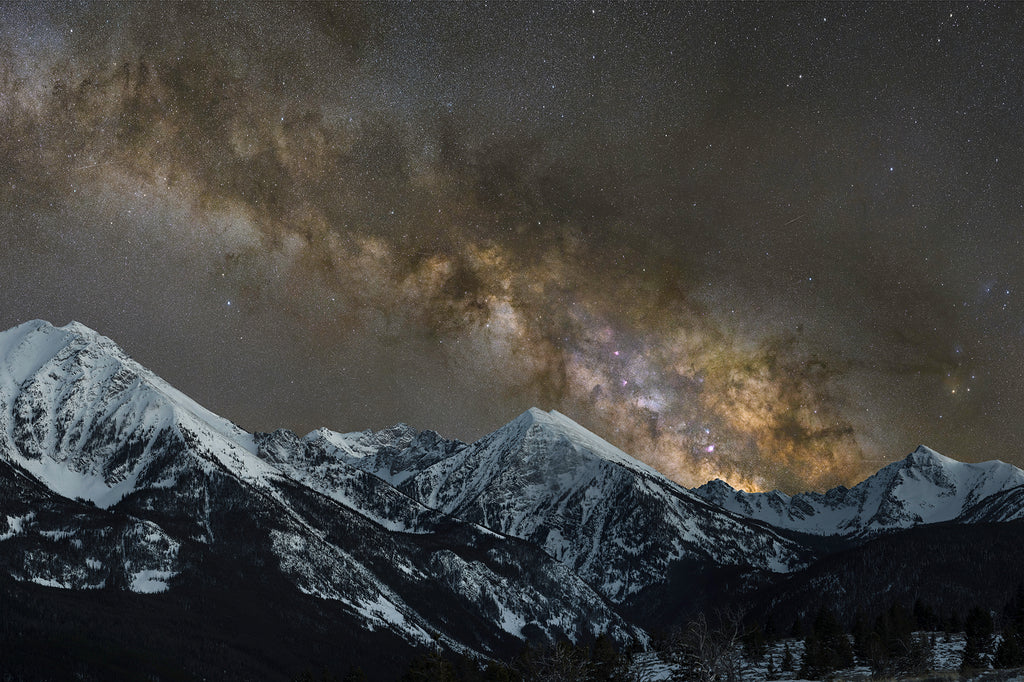It’s 1am on April 10, and the temperature is 14 degrees above zero. I’m not cold – yet – climbing a south-facing, steep ridge in a light sweatshirt, following a horse trail of frozen, muddy ruts. In my headlamp, I can see the imprint of steel shoes left by a pack string that returned from a remote hunting camp back in November. I wonder if they were laden with elk meat, knowing the odds were better twenty years ago.
Where the trail switchbacks below a dying, white bark pine, I think this would have been an easier ascent for me when the elk hunting here was better. My pack would have been a more comfortable weight, my steps a little longer, and I wouldn’t have looked for an excuse to rest. I might even have gotten an extra hour of sleep before beginning my hike. That thought spurs me onward before I’ve entirely caught my breath, as though increased exertion can rewind the clock.
I’ve come to photograph a portion of our galaxy over mountains that I’ve grown to love as much as any in Southwest Montana. Near the top of the ridge I’m working up, I can see them on the distant horizon, looming white against the black night, a thousand summer memories buried beneath deep snow and long, winter months. In high-elevation wind, snow peels from the summit of one, fading into the darkness like a comet’s tail. It’s as hard for me to imagine those mountaintops three months from now – brimming with wildflowers – as it was for me to conceive the difficulties two decades would add to my walk when I was a younger man. If nothing else, the kink in my left knee is assurance that summer will find Montana’s alpine.
But not tonight it won’t. I crest the ridge and, far from the scattered drifts of snow I’m expecting to see after our relatively open winter, find an unbroken expanse of white. Perhaps the same wind hurling snow from the peaks west of me has packed this sheet of winter hard enough to support my weight. I hike my leg up, gingerly testing this miniature glacier’s strength. It holds until I attempt a step forward then gives way as quickly as a hangman’s trap. I fare no better with my next step, sinking above my knees. It’s over a mile and a half to where I want to set up my camera, and it appears as though I’ll be “post holing” every step of the way.
When I’m in a hurry to get somewhere, time always moves faster than I do. The single-digit hours of this night outstrip my pace as time hurtles along in inverse proportion to my progress. It takes me more than two hours to cover what should have been a leisurely, half-hour walk, and when I finally break over a height of land, the unobstructed view of the Milky Way and Spanish Peaks Range in front of me, I’m winded and drenched in sweat.
I strip off my sweatshirt and stuff it into the bottom of my pack where it will freeze rock hard long before my photograph is complete. I exchange it for a dry spare, waiting as long as I can stand the sting of the frigid air against my bare skin before pulling it on, a down jacket on over it which I zip to my chin. It will be a race now between how quickly I can complete my photo and how fast my body loses heat, and it’s going to be a neck-and-neck finish.
It takes ten minutes to level my tripod, align my mount, strap handwarmers to my camera lens, and find perfect focus on a distant star. I can already feel the prickles of a country defined by cold by the time my shutter opens for the first time, an infant shiver beginning somewhere between my shoulder blades. As I move my camera across part of the horizon and then back again along the same path, a series of twenty photos, I think about the billions of human beings who have, from the time we first became endowed with self-awareness, looked into the night sky and doubtlessly felt much of the same wonder that I do now. There are over one hundred billion stars in our Milky Way alone, and NASA now estimates that there are as many as 2 trillion galaxies in the universe. I can’t get my head around the distances, the numbers, and the possibilities for what exists beyond the sliver of sky my camera captures.
I’m thinking about it, trying to decide how many of the universe’s mysteries I’d like to unravel and how many I’d prefer remain indecipherable when I realize that I’m chilled right to the core. My snow-soaked pants are as stiff as chain mail, my toes are rapidly losing feeling, and my fingers aren’t far behind. I stomp my feet and rub my gloves together, actions that provide diminishing results. Six more photos I tell myself. Less than fifteen minutes. I have to smile thinking about how slowly these few moments move compared to the hands of the same clock earlier in the night.
The second my last photograph is finished I begin disassembling my set up with all the dexterity of a zombie. I’m able to more or less get my camera zippered into a small, padded case, but the rest of my gear gets shoved roughly into my pack with no regard for either efficient use of space or the delicate nature of components. I need to get moving again, and I welcome the effort expended trudging through snow.
I make better time retracing my route across the snowfield, in part by stepping in my own tracks and also out of necessity to warm up. By the time I reach the ridge’s southern exposure and the bared-off horse trail, I’m beginning to sweat again and the eastern sky glows with something that is no longer the dead of night. From the base of the ridge, it’s a four-mile bike ride to my truck and another race against the seeping cold. I win it by a hair’s breadth, turning my engine to life in what is now early dawn. Through my windshield, I watch the silhouette of the mountains I photographed disappear behind the frosted condensation of my breath and then reappear as my heater blows warm air.
I’ll like thinking that I was up there, by myself on a cold night, when I drive below those peaks this summer. And I’ll enjoy watching them transform from a world of white to one full of vivacious life – hordes of mosquitos, families of mountain goats welcoming new kids, oceans of wildflowers, and the musty scent of elk on north-facing slopes of lodgepole pine. But first, I will enjoy memories of my view this night. An unfathomable expanse of stars above a land of snow and rock. I point my truck toward home, and, in my rearview mirror, believe that I can still see a faint star refusing to yield to day.
**It's been a beautiful spring of clear nights here in Montana. Enjoy these recent photos, all of which are available in my New Releases and also Night Skies collections**










Tanya Sousa
What you go through to get these beautiful images! :-)